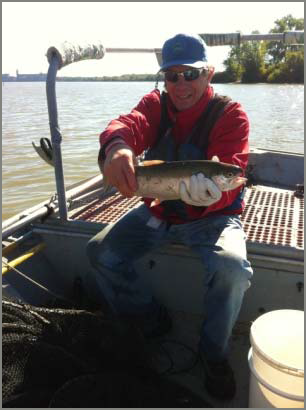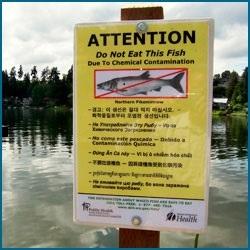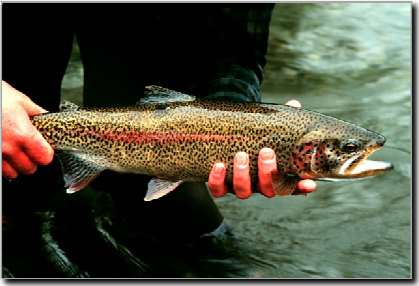Fish and Shellfish Advisories and Safe Eating Guidelines

Fish and shellfish are an important part of healthy meal planning. They are a lean, low-calorie, high quality source of protein. They contain essential nutrients, omega-3 fatty acids, and are low in saturated fat.
Well-balanced meals that include a variety of fish and shellfish can contribute to heart health and children's proper growth and development. Omega-3 fatty acids in fish benefit the hearts of healthy people and those at high risk of, or who have, cardiovascular (heart) disease.
However, some fish and shellfish (e.g., clams, oysters) may contain chemicals or illness-causing microorganisms like bacteria and viruses that could pose health risks to people. When contaminant levels are unsafe, fish and shellfish advisories help people make informed decisions about where to fish or harvest shellfish. Advisories recommend that people limit or avoid eating certain species of fish and shellfish caught in certain places.
All 50 states and some U.S. territories and tribes issue advisories to protect people from potential health risks of eating contaminated fish caught in local waters. EPA encourages states, territories and tribes to also issue safe eating guidelines. These guidelines tell people which fish they can eat safely and encourage eating fish and shellfish as part of a healthy diet.
What is an Advisory?

A consumption advisory is a recommendation to limit or avoid eating certain species of fish or shellfish caught from specific water bodies or types of water bodies (e.g., lakes, rivers or coastal waters) due to contamination.
-
People who eat a lot of fish
-
Elderly men and women
-
Pregnant women
-
Nursing mothers
-
Children
An advisory for a specific waterbody or type of waterbody may address more than one affected fish or shellfish species or contaminant. Advisories can be issued by federal, state, territorial or tribal agencies.
- Federal Advisory: EPA and FDA provide advice on eating fish and shellfish for women of childbearing age and parents or caregivers of children.
- State and Tribal Fish Consumption Advisories: States, territories and tribes provide advice on fish caught in waters in their jurisdiction. For current advisories visit each state, territory or tribe fish advisory website. Links can be found at the List of State, Territory and Tribe Fish Advisory Contacts
National Listing of Fish Advisories
From 1993 through 2011, EPA collected fish advisory information from states, territories and tribes. That information is available in the National Listing of Fish Advisories (NLFA). The NLFA includes fish advisories that were issued by states and territories from 1974 to 2011. To find historical fish advisories:
- List of State, Territory and Tribe Fish Advisory Contacts
- Search Historical Advisories Where You Live (Basic Search)
- Search Historical Advisories (Advanced Technical Search)
- Search State Fish Tissue Data
[Note: Some historical advisories may still be in effect.]
To view archived materials about fish advisories issued prior to 2012, search for “National Listing of Fish Advisories” in EPA Archive. Search EPA Archive
View the fish tissue data that served as the basis for state fish advisories.
For current fish advisory information go to State, Territorial and Tribal Fish Consumption Advisories.
National FDA-EPA Mercury Advisory
Guidelines: What is Safe to Eat?

Because fish and shellfish are such an important part of a healthy diet, EPA encourages states to issue safe eating guidelines to let people know what species are safe to eat. Safe eating guidelines let the public know when there are no limits on eating specific fish species.
These guidelines are developed based on data from fish that have been tested for chemical contamination and are found to be safe to eat. Like fish consumption advisories safe eating guidelines are issued for specific fish species from specific water bodies or types of water bodies by state and local agencies.
Contaminants: What is of Concern?

Chemical Contaminants
-
Mercury
-
Polychlorinated Biphenyls (PCBs)
-
Chlordane
-
Dioxins
-
Dichloro-Diphenyl-Trichloroethane (DDT)
Nearly all fish and shellfish contain traces of mercury, no matter what body of water they come from. The risk from consuming mercury by eating fish and shellfish may include harm to an unborn baby or a young child's developing nervous system if the mercury levels are high enough.
When developing the “Advice About Eating Fish”, EPA and the Food and Drug Administration (FDA) concluded that the following types of people should eat more fish that is lower in mercury for important developmental and health benefits:
- Women who may become pregnant
- Pregnant women
- Breastfeeding mothers
- Young children
The advice includes a chart showing how often to eat more than 60 types of fish and shellfish and supplemental questions and answers.
Bacteria, Viruses and Pollutants in Shellfish
Certain disease-causing bacteria, viruses and other pathogens can contaminate seafood causing foodborne illness. The FDA leads the National Shellfish Sanitation Program (NSSP) and the Interstate Shellfish Sanitation Conference (ISSC) Exit which were formed to promote and improve the sanitation of shellfish. Here’s how EPA's programs relate to the National Shellfish Sanitation Program.
By working collaboratively with state and federal agencies, the shellfish industry and the academic community, these organizations ensure the sanitary control of shellfish produced and sold for human consumption.
Harmful Algal Blooms
Harmful Algal Blooms (HABs) are the proliferation of toxic nuisance algae that harm natural resources and humans, including people getting sick or dying from eating contaminated seafood. Currently 85 toxic microalgal species have been documented. For more information on HABs, please refer to nutrient pollution.
Want to Learn More?
EPA's ACT: Stay Healthy by Eating Wisely provides more information for those who want to safely include fish and shellfish in their diets.
